The Red House >>
Some Photos >>
Our Life and House in Phillips Street aston by Rod
Birch >>
Shared Lavatory in a yard in Ladywood, 1968 >>
Phillip's Street 1970 >>
Sydenham Buildings by Pat >>
Johnson's Greengrocers by Brian Johnson >>

Ray Satchwell
Ray Satchwell's wife Hilda has kindly posted us a couple of photographs of the Red House.
This one has Ray on the step. The Red House was there during the war. I used to take our accumulators there to be charged up. It was then owned by Sid Philips and charlie Young who I worked for in the late 50s for a while.

Brian Satchwell and his Mom, Hilda Satchwell and their book keeper Mrs Ellis
all on the step of the Red House
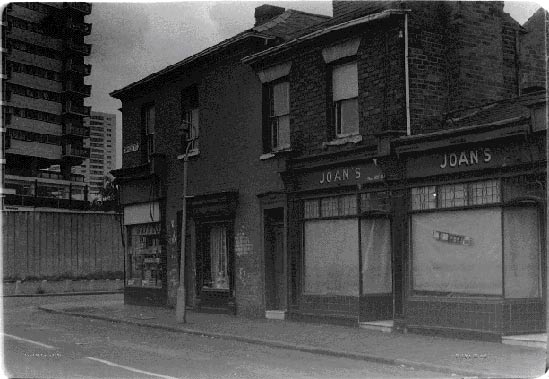
Baines Bakers & Joan Bennett's Woolshop 1970
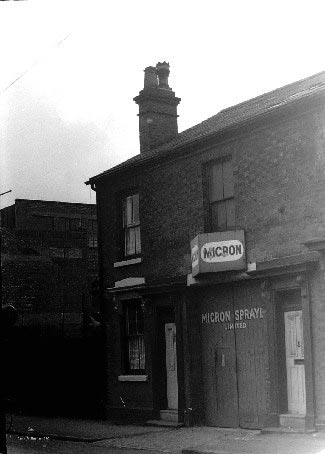
Micron Sprayers 1970

Friends of Harry Wayne, a group of workers at Millers Phillips Street Kindly sent in by a E Wayne
If you recognise anyone? please get in touch
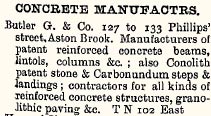
Our Life and House in Phillips Street aston by Rod Birch
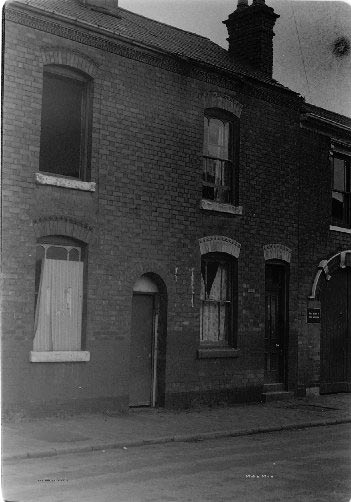
4a Phillips Street 1970
Living in warm, double glazed, centrally heated houses is quite normal by today's standards. We have cars to get us around, essential to our way of life and out of town shopping. We have gone through some hard times, my wife and I, but on reflection my understanding of hardship has been altered as the years have passed. Looking back at my childhood home, 4a Phillips Street, aston fills me with both longing and horror.
The conditions we lived under were horrible. The house was owned by mom and dad, but they were far from being rich. The condition of the house was very poor, although I don't mean dirty, not in the sense that it was not cleaned. My mom like most women then toiled daily against impossible odds to keep both the house and us children clean and fed. We were not the only creatures who inhabited our house! Black Bats, and Silver Fish were a constant source of complaint with mum, but kept us kids amused at odd moments. Here and there on the plastered walls were the bloody remains of many an unlucky bug that we had caught up with.
Our house had four rooms, two down and two up. Downstairs we lived our day-to-day lives, it was only when you went upstairs that you realised how badly off we were. My Grandad lived in one upstairs bedroom, until the early sixties. at this time my three brothers and myself, slept four to a bed. Two of us at the top of the bed, and two of us at the bottom. Mom and Dad slept in a separate bed in the same room as us, would we put up with these conditions now?
after Granddad died, us lads were moved into his bedroom. This was luxury for both us, and mom and dad too. But luxury of what kind? The house had some serious damage to the roof at the rear, and many slates were missing. On a clear night, it was possible to see stars, not that it was clear very often as I can remember. When it rained we got wet and cold, when it snowed in the winter of 1962 we had snow on our beds. Dad was in the civil Defence back then, and his Great coat came in very handy as a waterproof blanket. Many was the times we were sent to a local drycleaners to beg a plastic bag, to cover our beds.
The floorboards were stained with Distemper, a kind of powdery paint of the time, this had been washed from the walls by rain. If we woke in the night with a need to use the loo, mom kept a bucket for us to use, which was emptied daily. We were not allowed to have friends play in the house back then, and I know it was because mum was ashamed of the way we were forced to live and the poverty which prevented us from getting the roof fixed.
We were lucky though, compared with some families down our street, because we lived in far better conditions than some of those poor souls. I am filled with longing though for the friendships which grew out of those hardships. The sense of community belonging, and mutual respect which has long since gone. The ability to rise to a challenge, born out of need, no longer seems to pull neighbours together.
In fact being neighbourly now is a very different concept. Because of the state the roof was in the fuses often blew, due to the rainwater mixing with electricity? also we only had a 5amp supply, so most things, including the iron were plugged into the lighting circuit, with a sort of double adaptor available at the time. The situation was dreadful and I suppose by today's standards very dangerous.
We managed like this for years, if it rained and the wind was blowing in a certain direction, the fuses blew, if we plugged in too many things into the light, the fuses blew! My dad was an expert at "codging things up" and brought home a piece of paper with basic wiring instructions, also he brought home wire and a rather smart industrial fuseboard complete with fuses and installed a 15 amp supply, and rewired the lights. The only problem being, it was installed in the very same place as it was prior to improvement. Well, you guessed it, when it rained we had lightning inside the house as well as outside!! The other problem was that because the fuses were industrial we had to keep a supply in, because if it was rainy they could blow maybe two or three times a night. There was a few occasions we had to wait for dad to go to work before we got the power back on.
During the early sixties mum bought a telly from Rumbelows on Newtown Row, I remember vividly Twizzle, Supercar, Watch with Mother, Emergency Ward 10, the list goes on and on. To be honest I think I had as much fun looking in the back of the set as I had watching the screen, so many little red lights on all those valves, like a city lit up at night! I always wondered where the people went when the telly was switched off. The little dot stayed for ages, a phenomenon not seen on a modern day set. Prior to my parents buying the telly we had had a radio worked off an accumulator, which I think was some kind of battery. There was a radio shop up the road called The Red House, where the battery was taken for charging. We were, I know, very lucky and mom and dad must have used hire purchase to buy the set.

My Late Brother Tony with my Mum
In our back yard
Our source of hot water was a washing boiler, powered by gas! Mom would use it most of the day Sunday doing the whites and then a final brew up for the bath. If I remember correctly the gas then was filthy stuff and the pipes would clog up and so the flames would get smaller and smaller over a good period of time. The gas board would then need to be approached and they would bring a compressor and blow the pipes. My dad once had the idea that he could do this himself, so he connected the whole bloomin gas system up to the water mains and used that to get rid of the congestion. It worked to a point, but for weeks after we had funny coloured gas jets? as water was spit out of the cooker and boiler.
In our house having a bath was a Sunday thing, so we would be all squeaky clean for school on a Monday. In winter mom would light a fire in the kitchen grate and my brothers and I would take it in turns to have a bath. a question I would ask, is why did the bath have more water in it by the time I got my turn, I was last to bathe? The other memories of this are the red marks on my skin as the fire in the grate dried me as I sat in the bath watching the steam rise from my body. also our bath was very old and dad used Pot Menders to fix holes in the very thin tin. If I was lucky I got a towel or flannel to sit on, otherwise I had a very sore bum. Once bathed we were not allowed to play out again, mom always said we would get a cold! It was usual to be told to get up the "wooden hill to bed" after a bath. I always slept well after a bath, tucked up cosy and warm along with my brothers.
Shared Lavatory in a yard in Ladywood, 1968
We had the luxury of an outside loo to ourselves, so no sharing with other families. I remember first thing in the morning we would line up on the loo seat like birds on a telegraph wire, there was room for me and two of my brothers on that seat. We would take it in turn, sitting over the business part while the two who were waiting would read comics, which were kept for that very purpose in the loo. Sometimes your favourite bit of comic would mysteriously disappear, where too we did not know? Loo paper was of course old newspapers and in emergencies our beloved comics, but we also used posh stuff when we had visitors come.
Mom would send us up to the fruit and veg man Billy Kimberly his name was. He had a barrow on the corner of Phillips Street and Newtown Row, and we would ask for orange and apple papers, which were made of tissue. These we would thread onto a length of string and hang in the loo, but as I said, only if we had company! Later on, dad would often produce a roll of that Izal loo paper! amazing what he could get from work? It was more like greaseproof paper and not very efficient, I will not go into too much detail though about that. Honest to goodness newspaper then was so much better than the real stuff, it was so much softer.
Tony my late Brother and mum outside the rear of our house in the yard. You can see the state the house is in, and also I think it's kind of reflective of times then, while things were generally glum, we did have lots of good times too! at some point most evenings, one or two of us brothers would be despatched to the pub outdoor to get granddad's beer. He was a heavy drinker, and was by this time unable to get himself to the pub. We would go round to the outdoor with a big old cider bottle, the sort with a rubber screw in top, this would be filled with beer using a big copper funnel, the top was screwed down, and a gummed ansells label put over the bung to seal the bottle.
On more than one occasion we were able to carefully peel the label back of and sip some of the tasty booze from bottle. The label was then restored to the bottle top and we would nervously carry the bottle up to granddads room. For payment of the errand we would usually get "bugger off now ya little bleeders" which meant we could escape our grumpy gramps, our crime undetected.
There were big changes happening constantly in aston throughout my childhood. It was being ripped apart around us. Slowly but surely my friends were disappearing, the same must have been true for mom and dad. Neighbours they had always known were being re-housed. The houses and people that made streets, vanished block by block. all around us had become a giant demolition site. This was at first a dream for a lad, most kids had a den or two as a child to hide in, I had a whole street of empty houses, and it was an exciting place. It soon became very lonely, towards the end of this period in time, our block of four houses are all that remained of Phillips Street. a few of the houses which stood unoccupied at the other end of the street were the haunts of vagrants and we were not allowed to go near them.
Things had changed, since Margaret Reynolds disappearance, my parents kept a tighter rein. So, I had a giant playground and no-one to play with. I was in my final few years at school by now. Occasionally a friend would come visit, but most of the time after coming home from school, I stayed in and watched telly. Our turn to move was a long time coming, I think because of the fact that the house was owned by us and not the council so it had to go through compulsory purchase proceedings.
I at last left school and started work, within a couple of weeks we were offered an house in Kingstanding, mom returned from viewing it very excited and full of enthusiasm. We moved one Friday evening, on the back of an open lorry my brother Tony had borrowed from his workplace. Suddenly I had become an adult, and lost my roots at the same time. For some time the land occupied by our house, and the other houses and shops towards the Newtown Row end of Phillips Street lay waste.
I had been back on a number of occasions since the 1970's, to look at the place and pick around amongst the rubbish which lay around, on what was supposed to be a sports field. at these times I often thought "Why did you knock down my home, only to leave the cleared land as a messy playground" Today I returned once more, camera in hand, to take a snap or two of my childhood home. I was more than surprised to find a nice tidy park, complete with hundreds of Daffodils in full bloom! Young trees have been planted, and there are benches to sit on and watch children play safely on brightly coloured climbing frames. It's a grand sight, the scars of modernisation have healed at long last!

St Josephs House c1970 Picture courtesy Of colin Richards
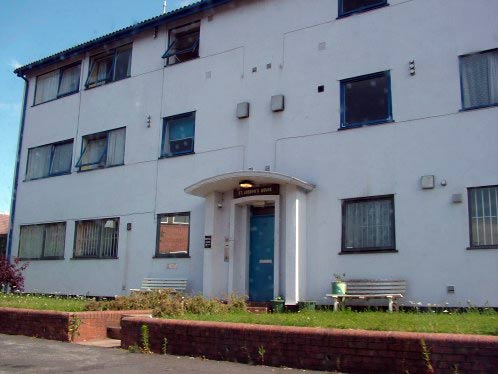
The Same Block Today 3/07/2004 Rod Birch
My parents moved to Sydenham Buildings about 1938, when I was one year old.My earliest memories are of being carted off to a neighbours anderson shelter at nights during the air-raids. We did eventually have a Morrison shelter ( a steel table with a mattress underneath) but, with my dad on aRP duties, I think my mother needed the company of others. Dad had a reserved occupation at the Norton Motorbikes factory.
Women not already employed in full-time work were told to take on prescribed jobs. I was an only child so my mother was told to work in what I remember her calling a 'blacking shops,apparently a filthy, stinking job that even men wouldn't want to do. There was nothing 'sexist' about jobs during the war! Dad kept chickens (for Xmas) and we had a duck that never laid so my mom said it was next for the table. an old lady, a few doors away, came running down when she heard this, begging us to keep the duck. It seemed whenever she heard it making a hell of a noise she knew the air-raid sirens would sound soon afterwards. Because of this she had time to pack a few things and was always first in the shelter. The duck won its reprieve.
Opposite Sydenham Buildings was the Shelley factory and further along on the corner of Elkington Street was Millers factory, both linked to the motor car and bike industries, and both the target of those night-time raids. I remember going to the little newspaper shop near Shelley's for the Beano and Dandy. These were fortnightly comics in those days. I would also have to try and get my dad a packet of five Woodbines which were very much under-the-counter and only for favoured customers. I can't remember the name of that shop but, further along on the opposite side was Hill's grocery shop. Old Mrs Hill had the shop in the front room of her house. I would go there for crusty bread but, for an extra penny, I could have one wrapped (!) and, eventually, for another penny, I could have a sliced loaf. Such luxury.
Towards the top of Sydenham Bldgs., on the left hand side was the approach to the woodyard, or sawmills, and after the war, in this opening we'd have our own bonfire on November 5th, with baked potatoes and ancient chestnuts. at the end of the war tables were erected in the cul-de-sac for whatever rationing would allow for a party. Then came the fireworks. I was very confused by the word Peace because, at the age of 7, I'd only known War and thought that was the way of things.
at the other end of Phillips Street,just past Elkington Street and the outdoor on the corner, towards Newtown, there was a family very much into the brass band business and they came marching along the street blowing trumpets and banging the drum and we kids all joined the 'procession'. One day after the war my mom came home with a banana and asked me if I knew what it was. Well of course I knew, I'd seen them in the movies in carmen Miranda's huge hats. What I couldn't believe was that this one was real, that I could actually eat it! Oh wow. Our playground was the middle of the street but we'd get a bit peeved when, every half hour or so, a car would come along, interrupting our game of leap-frog or hopscotch. Such cheek! On the end wall of our cul-de-sac we'd chalk up some wickets and play cricket, being very careful to hit the ball away from the front gardens. Most people didn't mind us getting our ball back but one old couple (they seemed very, very old then but were probably my age now) would refuse to let us rescue it from their garden and they kept them!
Going left out of the Buildings, on the immediate corner was a row of wooden work shops and an upholsterer named Jack Hunt had the first one. There were a couple of cottages (one became a cafe) and then, towards the corner of Thomas Street, a huge building called the Telson or Telsen and I would watch the huge shire horses taking the drays loaded with beer barrels from here. I think it belonged to ansells. It sort of made sense that there was a blacksmith shop opposite and I still remember the stink when the smith put the hot shoes to the horse. But my favourite horse was the milkman's. I would walk along Phillips Street with him on my way to school, feeding him chunks off my lunch sandwiches, (the horse, not the milkman).
On the left-hand corner of Phillips Street and aston Road was Wrenson's grocery shop. I think the manager's name was Mr Lycett. I remember him telling my mother whenever he had some REaL butter in. It would be in a big block and he'd cut of a chunk and pat it into shape. I think it was Danish and was white and tasted wonderful. In those days biscuits came in large tins with see-through lids and, if she could afford it, we'd have half a pound of mixed. Of course, my favourite shop was Woolworths, near the cross. I can still conjure up that wonderful smell that was so typical Woolworths. It met you at the door, playing havoc with the senses, a mixture of sweets, - aniseed, humbugs, liquorice etc.,(unwrapped), biscuits (unwrapped) bath salts (not unwrapped, but not air-sealed.) soap, leather and loads more. It was heavenly. Oh, and the wooden floorboards, sprinkled with sawdust at night.Today's Woolworths' are soulless places, no different to any other.

Jounson's Greengrocers - 34 Phillips Street - 1927
I lived in Phillips St (No. 34) from my birth in 1949 until we
were re-housed in about 1969 I think, however my Grandmother and Grandfather ran
a greengrocers shop at the same address back in the 1920’s. (we had old
greengrocer paraphernalia in our shed for years)
The woman and man are my Grandparents (Johnson), she is holding my aunt Mary and
the young lad is my father alfred Johnson. as Mary was born in Nov 1925, I think
the photograph was probably taken in 1927 when my Dad would have been 11